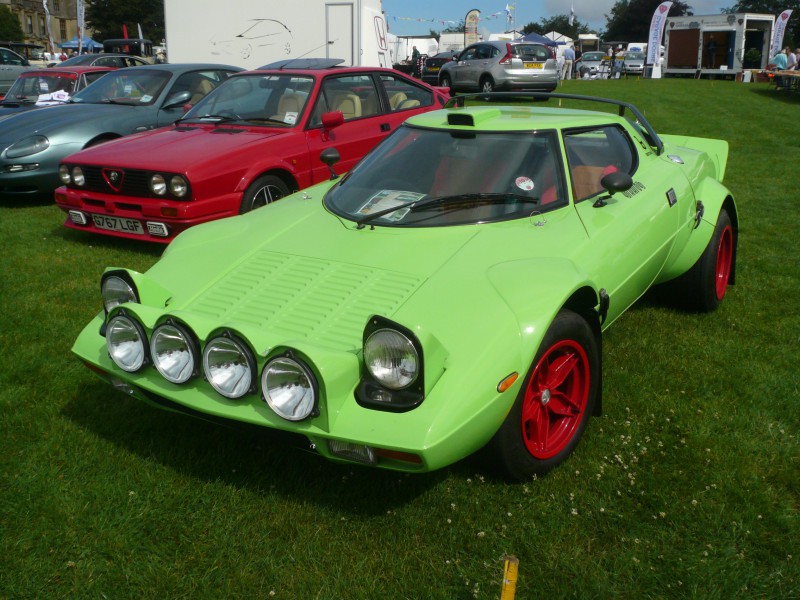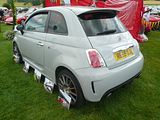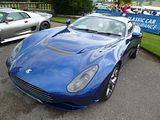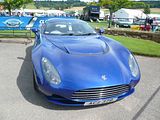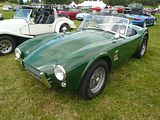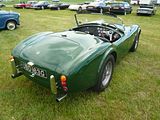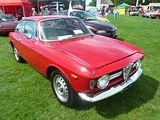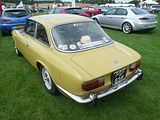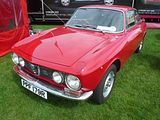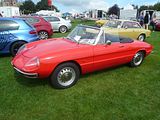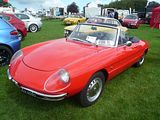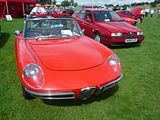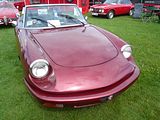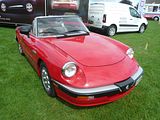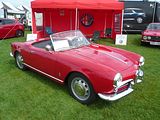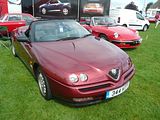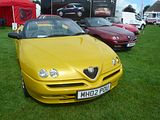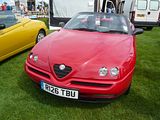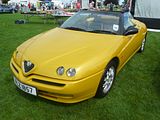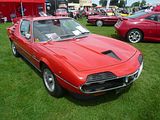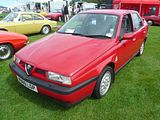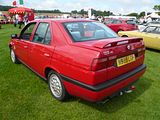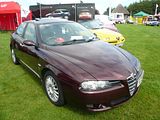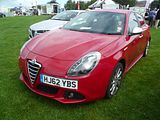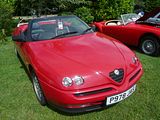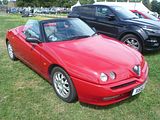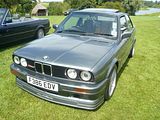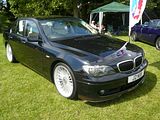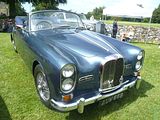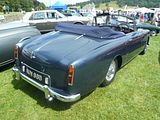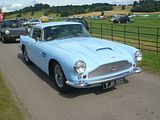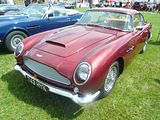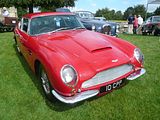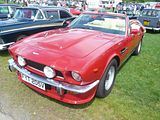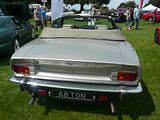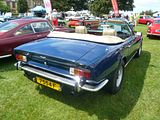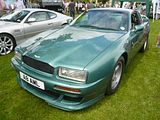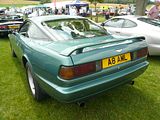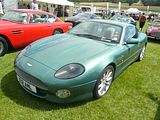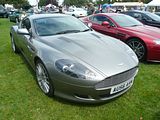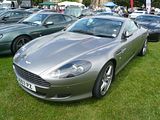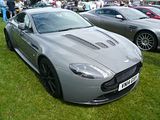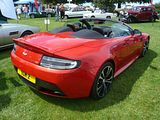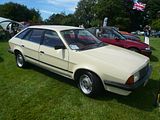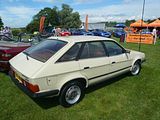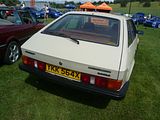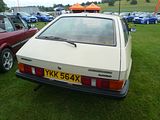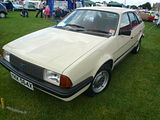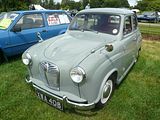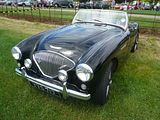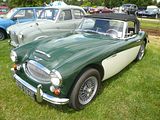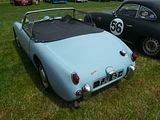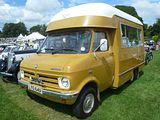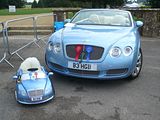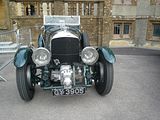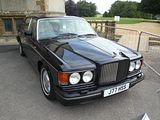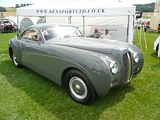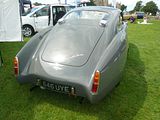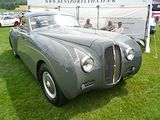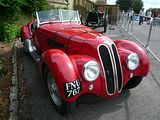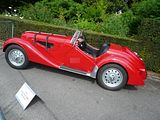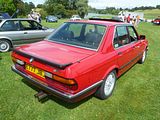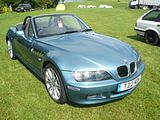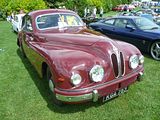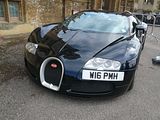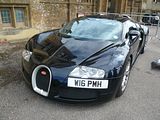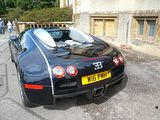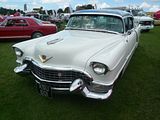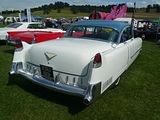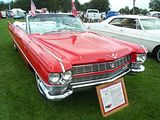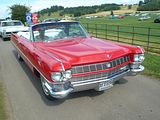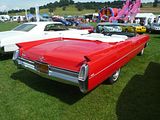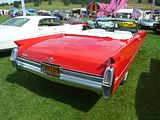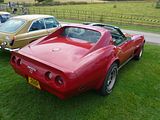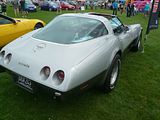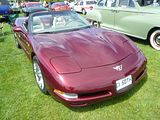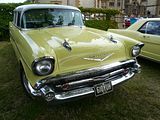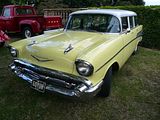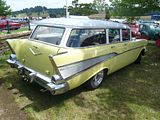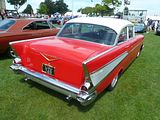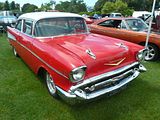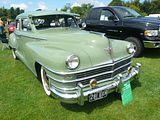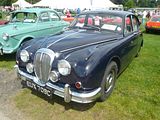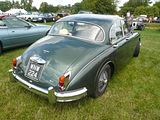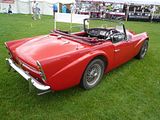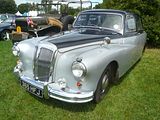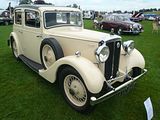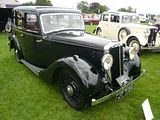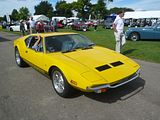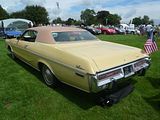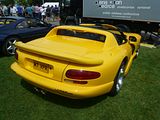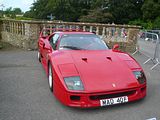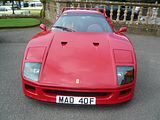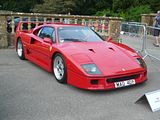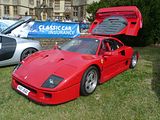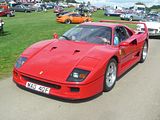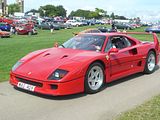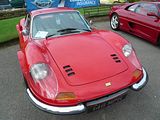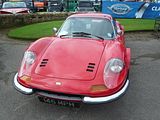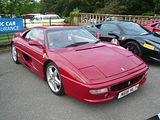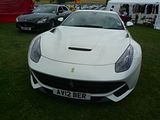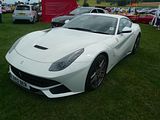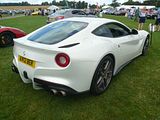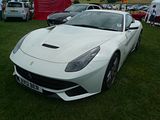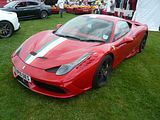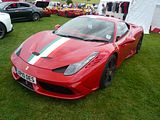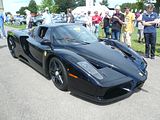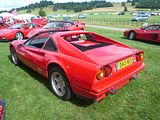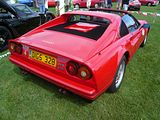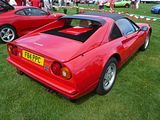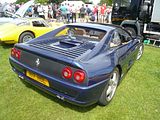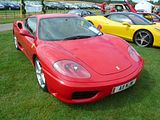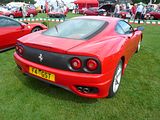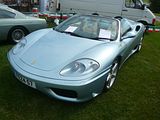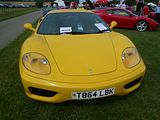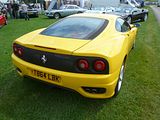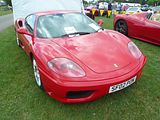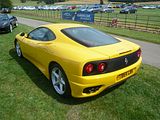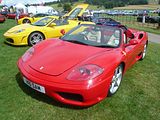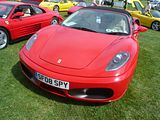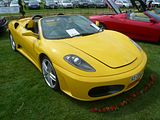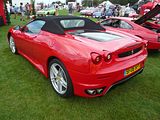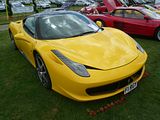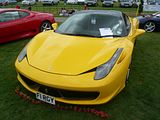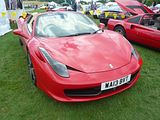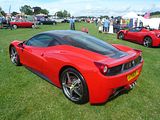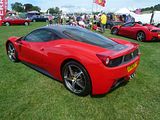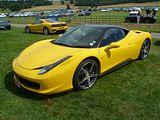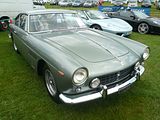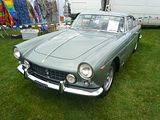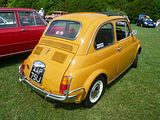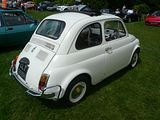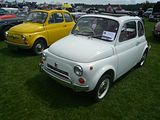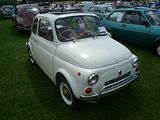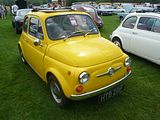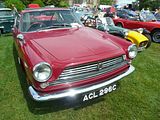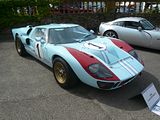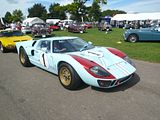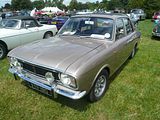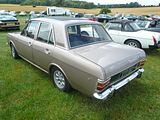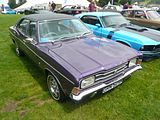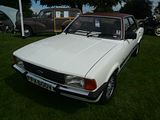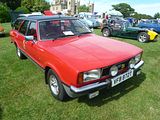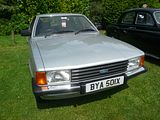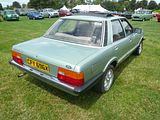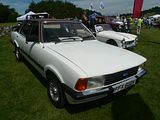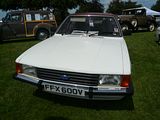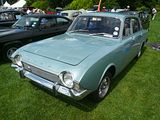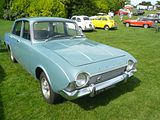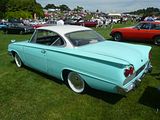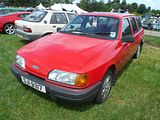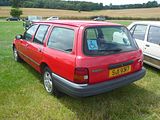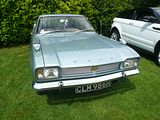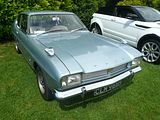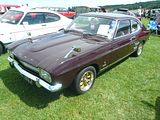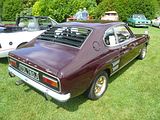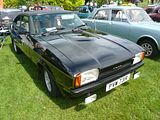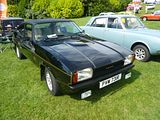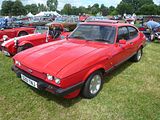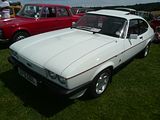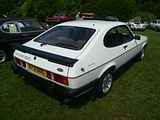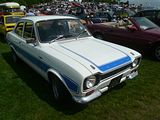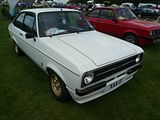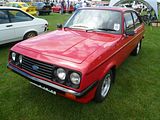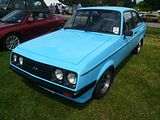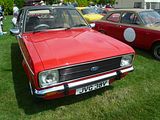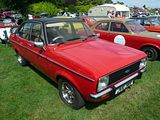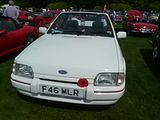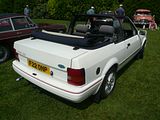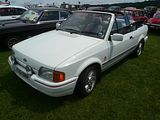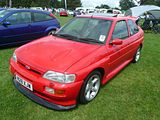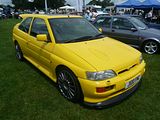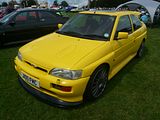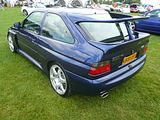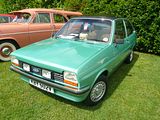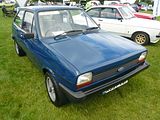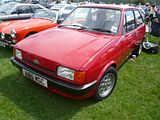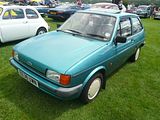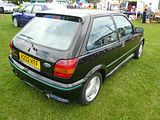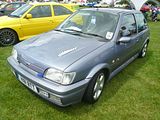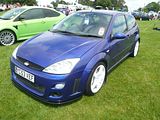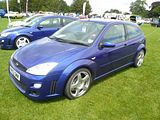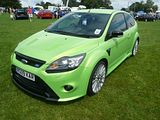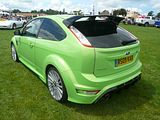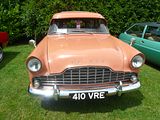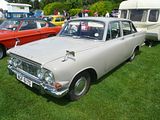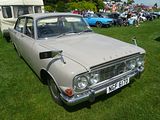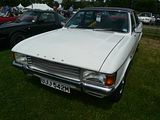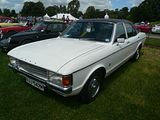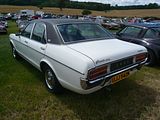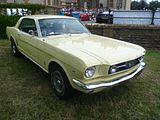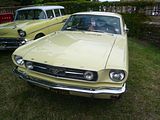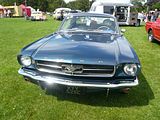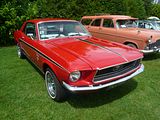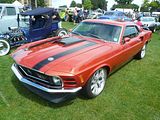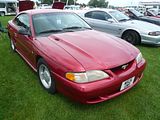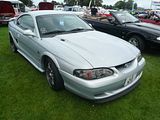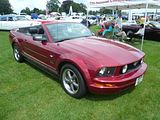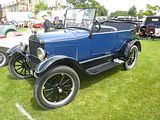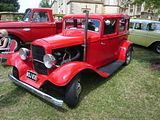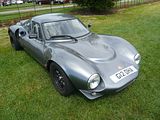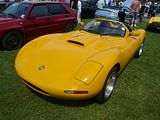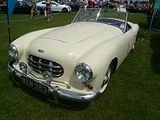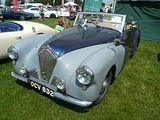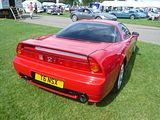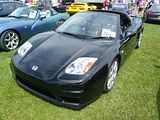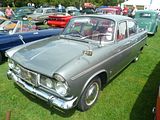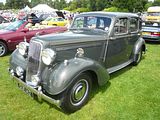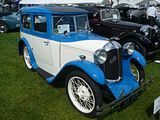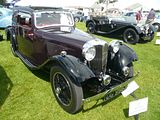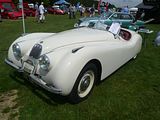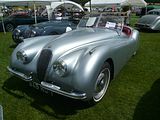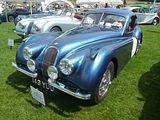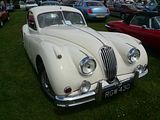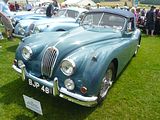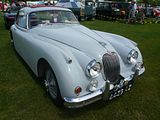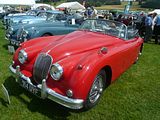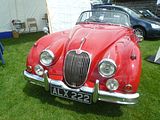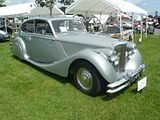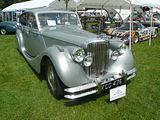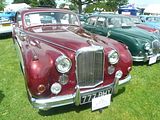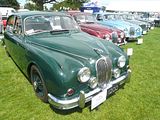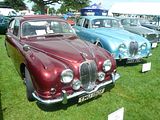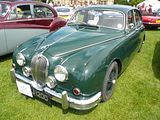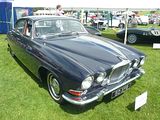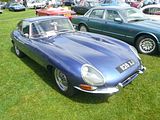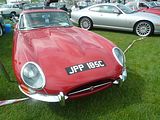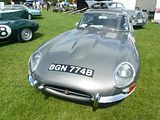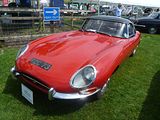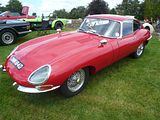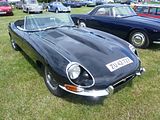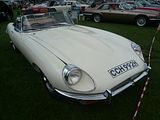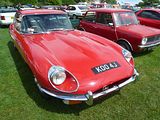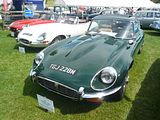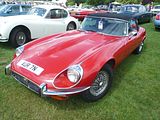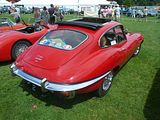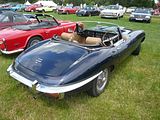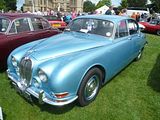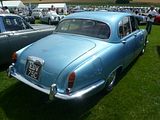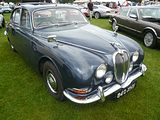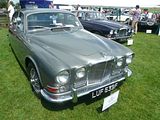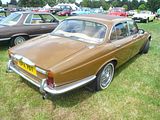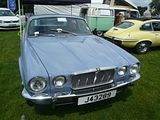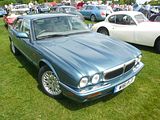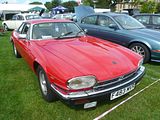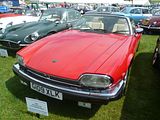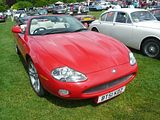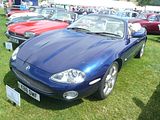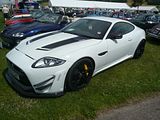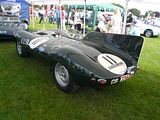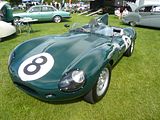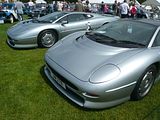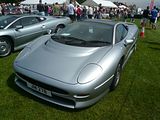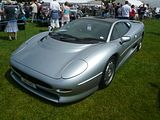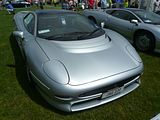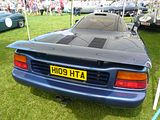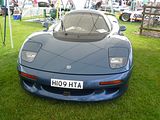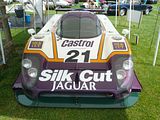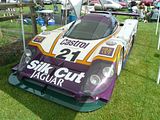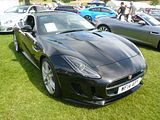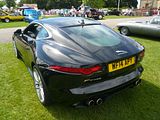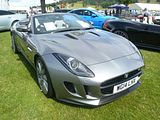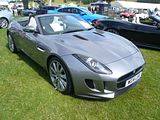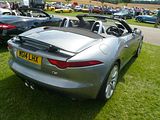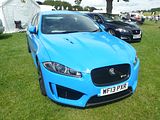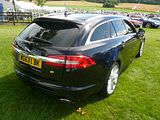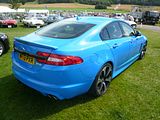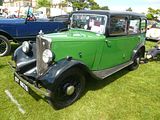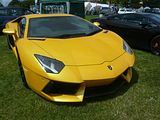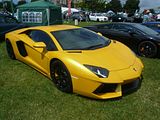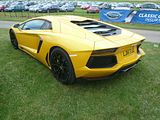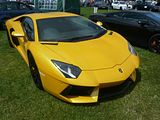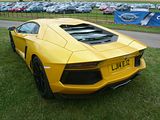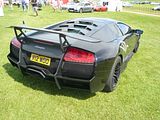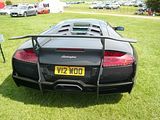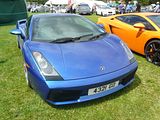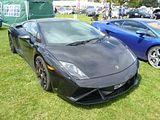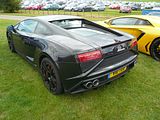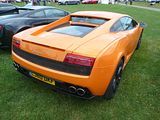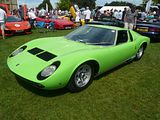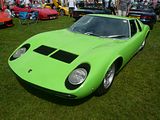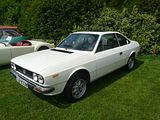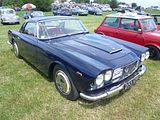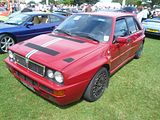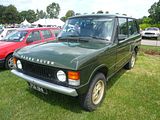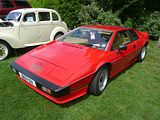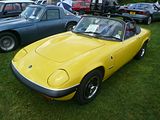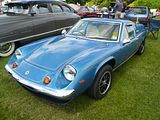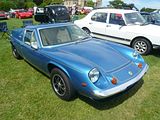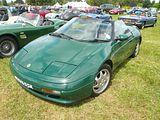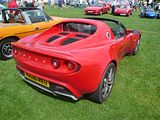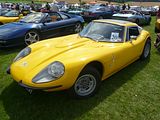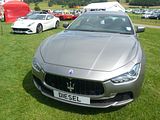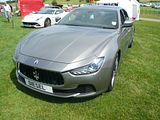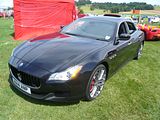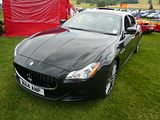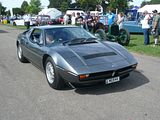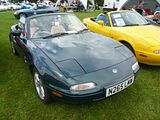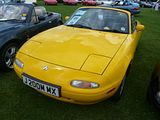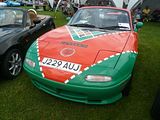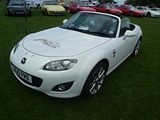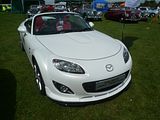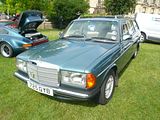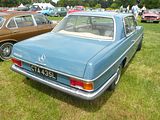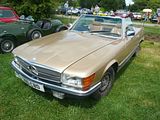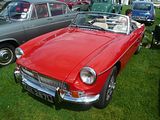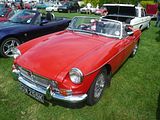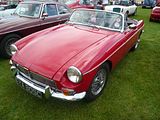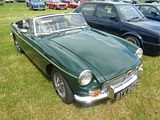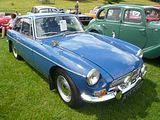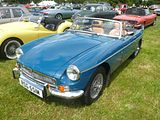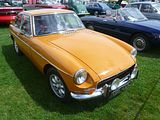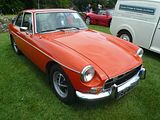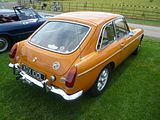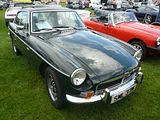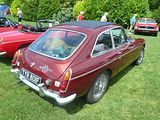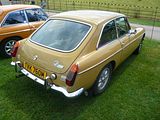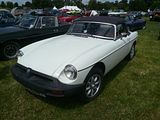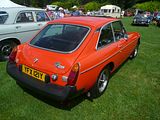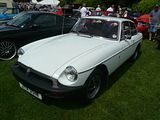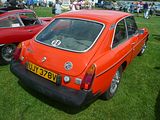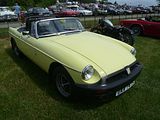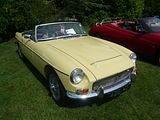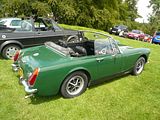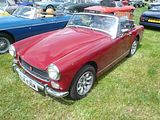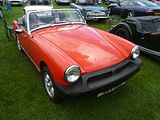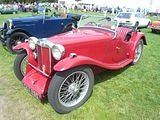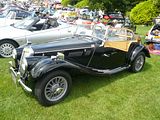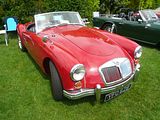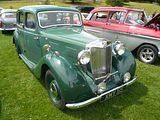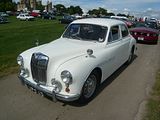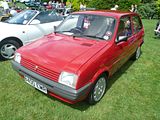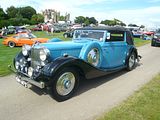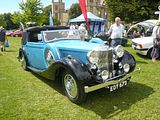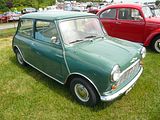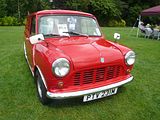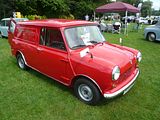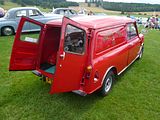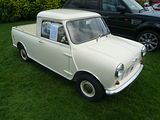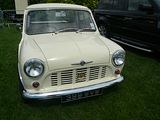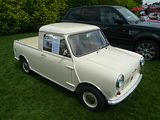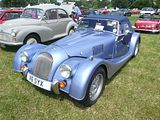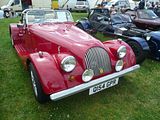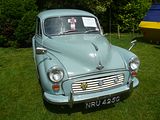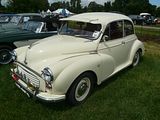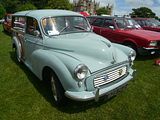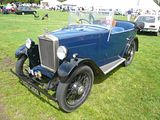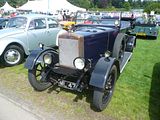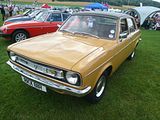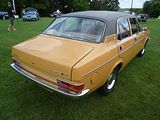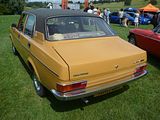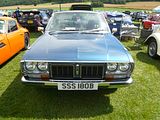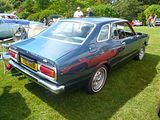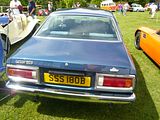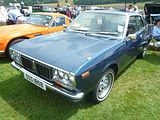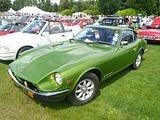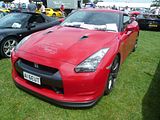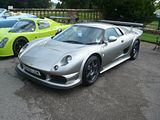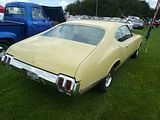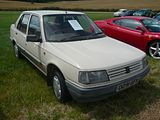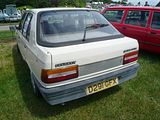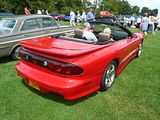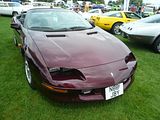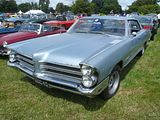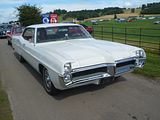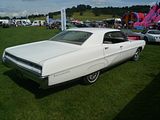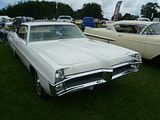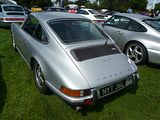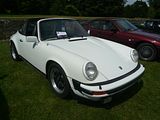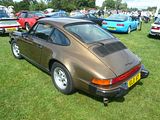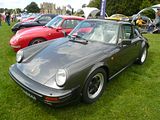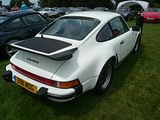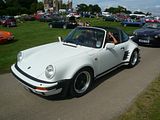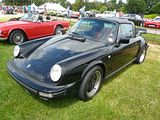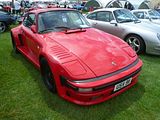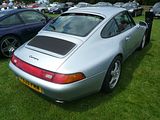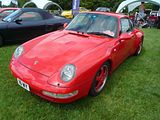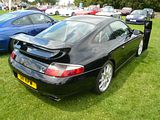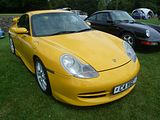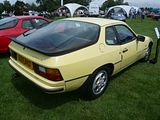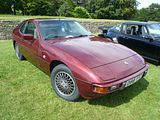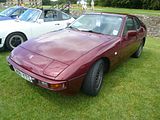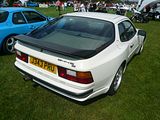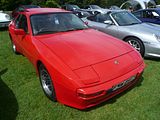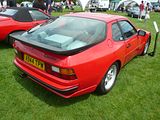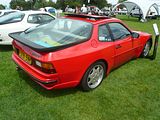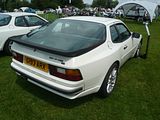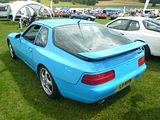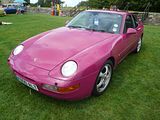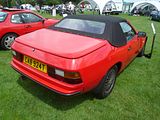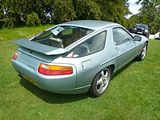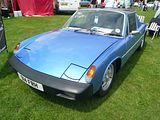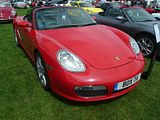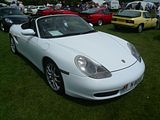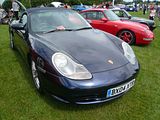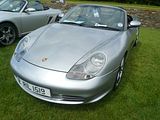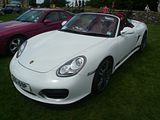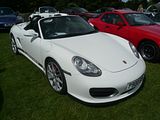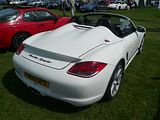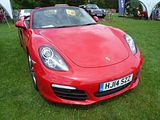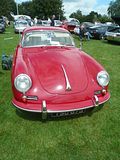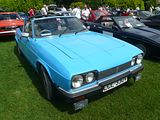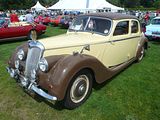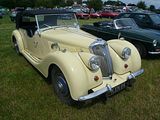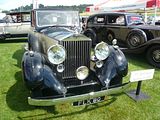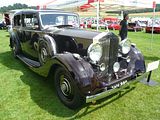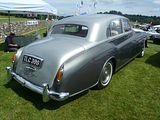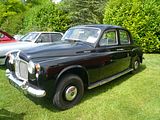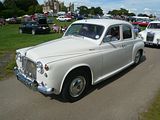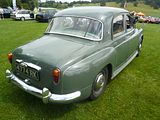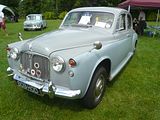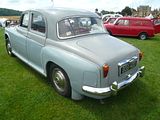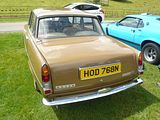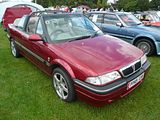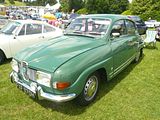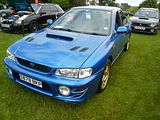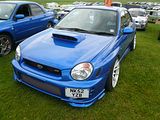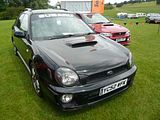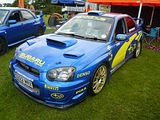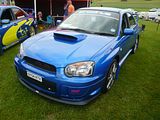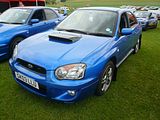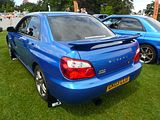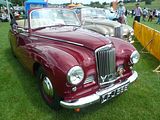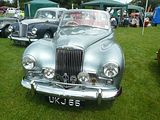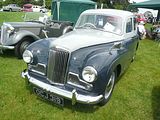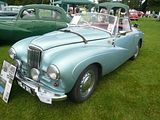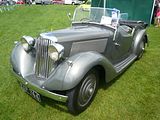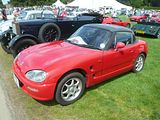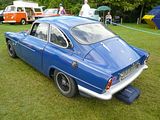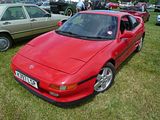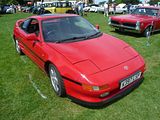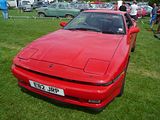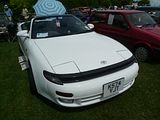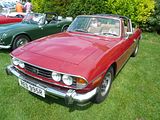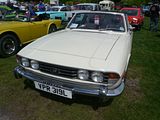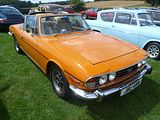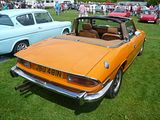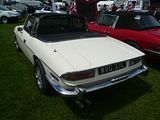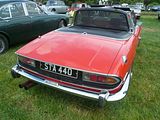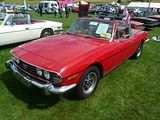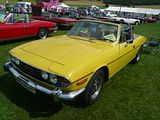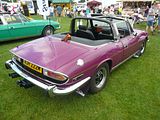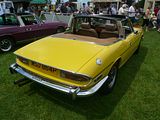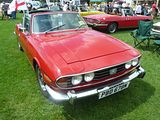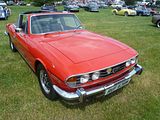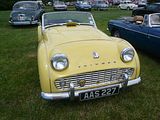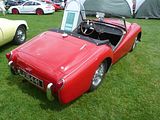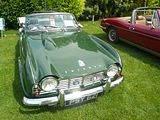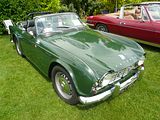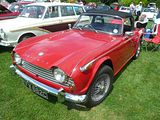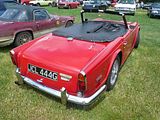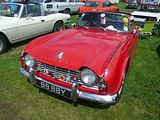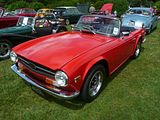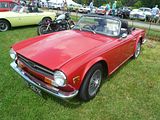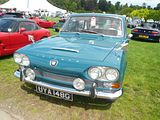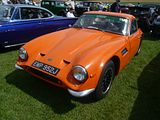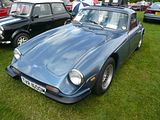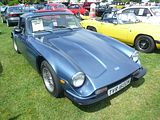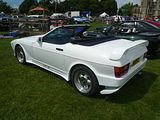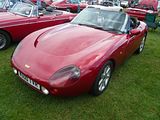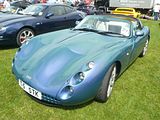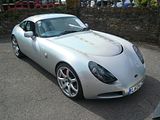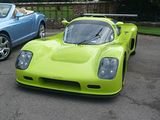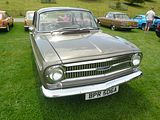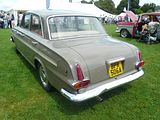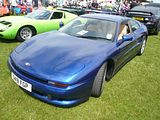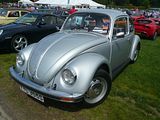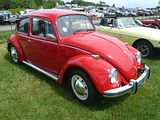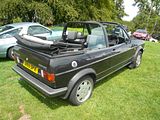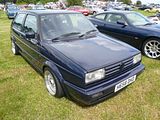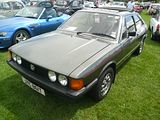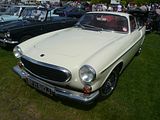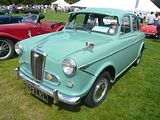Located just off the busy A303, highway to the South West, the old Roman town of Sherborne is probably best known for its famous Public School and its Castle. However, the car enthusiast will perhaps have made a visit there at some point in the last 11 years as in mid July it is also the location for what has become a massive assembly of classic and interesting cars, called “Classics at the Castle”. Held in the grounds of the Castle, over 1000 vehicles typically attend, with an interesting mix of supercars, car club displays and unaffiliated individuals who bring along their cars, all assembling to keep the show go-er more than entertained for a whole day. As if that’s not enough, a parade of PistonHeads cars arrive around 1pm, following a spirited drive around the Somerset and Dorset countryside, and the Castle itself is open for those who want a break from things automotive. I attended for the first time in 2011, and enjoyed the day, but since then, it has tended to clash with something else that I had earmarked for my schedule. Although there were clashes in 2014 as well, I had already decided that it was time for a return visit, and then I got an email from Paul Hanmore, of the Italian Auto Motor Club offering me a free ticket if I could bring the Abarth along as a display car. Needing no further encouragement, I put the event in the diary, cleaned the car, reminded myself exactly how to get to Sherborne, and then on the appointed day, set off. The sun shone all day, and cars poured into the grounds of the Castle until well into the afternoon. It was a splendid event, and the camera was very busy as you can see.
ITALIAN AUTO MOTOR CLUB
I knew that Paul Hanmore was coming in his Maserati 3200GT, as he followed me all the way from Shepton Mallett, but when I arrived, there were already several cars parked up in our display area, and everyone else arrived within minutes, giving rise to a varied display which ranged from a Hawk replica Stratos through David Roots’ Alfa Special and Jeremy Dutton’s glorious Alfa 1750 Spider, a late model Alfa Sprint, a nicely presented Fiat Barchetta, a lovely Fiat X1/9, a Lancia Fulvia HF Coupe, a duo of Lancia Delta models in Integrale and HF Turbo guises, a Ferrari 360 Modena, as well as Paul’s Maserati and my Abarth.
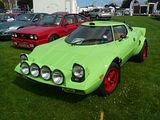

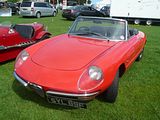

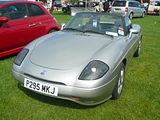
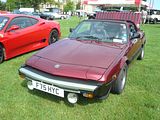
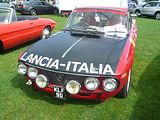
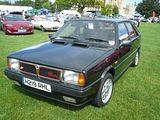
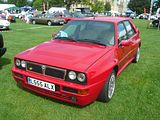
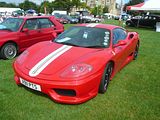
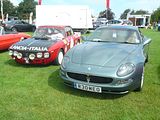
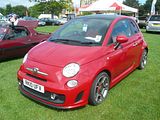
Many thanks to David Roots for the generous supply of cake which appeared from a secret compartment in his Alfa Special. Much appreciated!
ABARTH
There was another Abarth present, parked up just opposite mine, an early 500 model.
AC
The prototype AC 378 Zagato was making another appearance. This car was originally premiered at the 2009 Geneva Motor Show by a South African company called Perana Performance Group. Called the Z One, it appeared on the Zagato stand and it was announced that production versions would be by Hi-Tech Automotive in East London South Africa. In 2012 AC announced that the former Perana Z One was to be built under license with the AC 378 GT Zagato name at the same Hi Tech facility in South Africa. Since there, although there has been the occasional ambitious statement about its imminent entry into production, as far as I can tell, all that has happened is this one prototype gets displayed at various events and people express how they like it.. I presume funding remains an issue.
There were a number of Cobra style cars on show, reflecting the popularity of this machine.
ALFA ROMEO
There were some lovely Alfa’s on the stand which adjoined the IAMC area. Several of them were 105 series cars, with an array of GT/GTV Coupes and Spiders.
The earlier Giulietta Spider was also on show. To my eyes, one of the prettiest cars of the 1950s and 1960s.
Continuing the Spider theme were some 916 series Spiders. With the oldest of these cars about to reach their 20th birthday, and production having ceased 10 years ago, they have become almost instant classics, and surely that is a surprise to no-one as they look good, sound good and drive well.
The centre of the display contained a particularly lovely Montreal, the V8 engined car that came about when Alfa decided to productionise the concept that was shown at, and named after, Expo 67 in Montreal.
The 155 is one of those cars which met with a certain amount of disappointment or indifference when new, but which has a loyal following, and as a surprising number of cars seem to have survived, there’s often one to see at events like this. Today was no exception.
There were plenty of more recent Alfa on show, too, including a facelifted 156 in the rare colour of burgundy, a 159 Ti and the current Giulietta.
Elsewhere in the show, there were plenty more Alfas. One of my favourites was this fabulous Giulia Super. These saloon cars have never had quite the popularity of the Coupe and Spider models that they sired, but I reckon that they make for a very interesting classic. What surprises most people is that the very boxy looking body had a drag coefficient of just 0.34cd, which was way ahead of any of its rivals at the time or even for some years after production ceased.
There were a number of Spiders to be found elsewhere, too, with examples of both the long running 105 Series and the later 916 cars.
ALPINA
A trio of Alpina models were parked up among the (few) classic BMWs. As well as a C3 (based on the E30 3 series) was a much rarer 7 Series based car and an RLE, an Alpina version of the Z1, just 66 of which were made.
ALVIS
This convertible TE21 is very elegant indeed. Alvis cars, built in Coventry, appealed to those who could not quite afford an Aston or a Rolls Royce, but who wanted something that was not flashy and was well built.
ASTON MARTIN
There was a vast assembly of Aston Martin models, with most varieties that have been offered since the 1960s on show, as well as a few earlier cars.
The DB series of cars from the 1960 were represented by examples of each of DB4, DB5 and DB6, all of the absolutely fabulous. The market rates the DB5 the highest, but I have a soft spot for the later DB6.
From the generation that started with the DBS in 1967 and ran for over 20 years were a couple of very pleasing V8 Volante models.
Languishing in the doldrums of “not as good as the car it replaced” unpopularity for a long time, the Ken Greenley styled Virage models from the 1990s are gradually being seen as more desirable, and whilst the early cars are still seen as a bit insipid, the later Vantage models like this one are held in higher esteem.
It was with the 1994 DB7 that things really changed for Aston. This exceedingly good looking car literally saved the marque. Originally conceived as a possible Jaguar design, it morphed into a real Aston, even if there was a lot of XJS under the skin.
The first Vanquish is still a very good looking car to my mind. Instantly recognisable as an Aston, the wide rear haunches tell you that this car means business, as indeed it does.
There were plenty of recent or current models, too, as you might expect. I know that there are enough detailed differences that the cars should be easy to tell apart, but whilst you would never doubt that they are all Astons, you need do need a second glance to be sure you have labelled them correctly. Smallest and cheapest model in the current range are the V8 Vantage-based cars, and there were both V8 and V12 versions of these in the display.
The DB9 was also well represented, as was the latest Vanquish



AUDI
Seven years after making its production debut, Audi’s R8 still pulls in the crowds, punching well above its weight in the supercar stakes. This V8 model had people around it most of the day.
AUSTIN
I followed this car in, an Austin Ambassador. During the day it certainly attracted plenty of attention, but I don’t think anyone say anything nice about it. General view was that was a truly awful car. I think that is probably a bit harsh, as the basic design of the Princess which preceded it was sound, let down by shoddy build quality, and this one fixed one of the bigger weakness in providing a hatchback. Much roomier than any of its competitors, it did suffer that by the time it was launched in 1982, Vauxhall were selling the the truly excellent front wheel drive Cavalier, so this car’s biggest crime was probably that it was about 5 years too late. Needless to say, the model had a short life, and is now rarely seen, or even remembered.
I doubt anyone has forgotten this much older Austin, though. The A30 and A35 were small cars sold in the 1950s that competed against the Morris Minor and Ford Anglia. These days they have an enthusiastic following from those who love their simplicity and the fact that they are apparently quite good to drive (in a basic sort of way).
AUSTIN-HEALEY
The Big Healey is a staple of the classic car scene in the UK, so no surprise to come across examples of both the Healey 100 and the later 3000 model.
As far as I could tell, this was the only Sprite present.
BEDFORD
Motor caravan conversions of vans were very popular in the 1960s and 1970s, as these gave people the chance to head off for the weekend (or longer), without the need for expensive hotels or the challenge of towing a caravan. A handful have survived, and they always create a lot of interest wherever they are shown, especially the rare models, ie those not based on the Type 2 VW! This Dormobile conversion is based on the Bedford CF van.
BENTLEY
This Continental GTC was displayed with a matching small scale version for Junior. I suspect that even the little one does not come cheap!
A further pair of Bentley models were backed up against the house: a 4.5 litre from Bentley’s glory days in the early 1930s was parked next to a Brooklands model from the early 1990s.
I came across this unusual car on a trade stand, and there was a complete lack of information about what it really was, apart from the Bentley badges and a script reading Le Sarthe on the back. I saw it again at Silverstone a week later, where there was more detail provided. As I guessed, it is a modern body, built on an early 1950s Bentley R Type, and the blurb talked about it being a “Special Bentley” as opposed to a “Bentley Special”, even though it is the latter as well. As far as I could tell, to date it is a one off, but if you wave the appropriate quantity of monies around, BenSport Ltd could be persuaded to build one for you as well.
BMW
This year marks the 80th anniversary since Frazer Nash secured a contract to import (and put their badge on) BMW cars, and in honour of that, and also because it is a wonderful sports car, there was a 1938 328 model on show in the super car area.
A small number of “classic” BMWs were gathered together in a display right at one end of the show, and these included an E28 version of the M5, various E30 3 Series including a Baur convertible and a Z3.
BRISTOL
Sole Bristol model at the event was one of the very distinctively shaped 401 cars.
BUGATTI
Definite highlight for many was the appearance of a Veyron. It turned out that this is the car of Lord Pembroke (of Wilton House fame), now shorn of the wrap which has covered it for the last couple of years. Despite people asserting that it is black, it is in fact a very dark navy blue.
CADILLAC
There were a number of classic Cadillac models present, and with their bold styling and lashings of chrome, it was hard to miss them. Among them were a 1957 62 Series Coupe De Ville as well as a later (and more restrained, but even larger) 1964 Series 62 Coupe de Ville Convertible.
CHEVROLET
Corvette models on display ranged from a late 1970s C3 car, through some of the more recent models, including an example of the special 50th Anniversary model that was produced in 2003.
Of the Tri-star cars that constituted Chevrolet’s range from 1955 to 1957. it is the ones from the last year of production which command the most interest and the highest prices. Bel Air models sat at the top of the range and these are the most sought after of the lot. Whilst it is the open top and 2 door cars which collectors really seek, Wagons like this one are also in demand. There was a Coupe present as well. Looking at these cars, it is not hard to see why they are so popular, as they really do represent a perfect period piece of Americana.
CHRYSLER
Dating from 1948, this Windsor New Yorker sedan was a splendid example of the sort of car that all the US manufacturers were producing once their post war production got back into full stride.
DAIMLER
There were a number of the V8 250 models on show, both as individual display cars, and also included in the much bigger and comprehensive Jaguar area. This car was based on Jaguar’s much loved Mark 2 saloon but had its own Daimler-specific V8 2.5 litre engine, which it shared with the “Dart” sports car. Initially sold only with an automatic gearbox, the car had, I understand, quite a different character from the more sporting Jaguar, aimed at the person who wanted a luxury cruiser. In recent years, interest in these cars has grown and they are no longer quite the poor relation to the Jaguar that they once were.
Needless to say, there were a number of examples of the Dart SP250 sports car. Not well regarded when new, these have enjoyed something of a resurgence, not least because well known pundit Quentin Willson has one, and he says that he rather likes it.
The Majestic was the last Daimler-only model offered by the combined Jaguar-Daimler organisation. A clever update on the Century models that had been offered in the 1950s, in many ways t was like a cut price Rolls-Royce, offering a quality finish in a large and rather imposing looking car.
A number of pre-war Daimlers were to be found on display, with a Lanchester and a BSA (both of which were marques that Daimler acquired) for good measure. This 1935 Daimler Fifteen had a 6 cylinder version of the Lanchester Ten 4 cylinder motor, and as such was the first Daimler to be equipped with poppet valves in place of the marque’s hitherto favoured Knight sleeve-valves.
De TOMASO
This was a relatively early Pantera, with the purity of Tom Tjaarda’s elegant design still intact before the ever wider wheel arches and larger spoilers were added to the car.
DODGE
This Dodge Monaco is the sort of “personal Coupe” which was so popular in the US in the 1960s and 1970s, but demand for which has so completely dried up that next to no manufacturer offers this type of car any more.
I believe this is the only bright yellow Viper in the UK. Whatever, it is certainly a striking car and one which attracts plenty of attention even when finished in more sober hues.
FERRARI
There were 2 examples of the F40 on show, one in the special supercar area, and another close by.
Also in the supercar area were a trio of other models: a 458 Italia, an F355 Berlinetta and a 246 GT Dino.
There were a much larger number of Ferrari models to be seen in an area which was shared between a local dealer and the Ferrari Owners Club. The former had two of the latest models on display: an F12 Berlinetta and a 458 Speciale.
The latter had a sizeable display of cars, with plenty of interest. Centrepiece, without doubt, for most people was the black Enzo, and this was a real crowd puller.
There were plenty of the 8 cylinder models from the past 30 years or so, with a 328 GTS joined by a number of 360 Modena and F430 cars and several of the current 458 Italia and Spider.
There were not many 12 cylinder cars, though later in the day I did come across this Testarossa.
Oldest Ferrari on show, by some margin, and in many ways the most elegant of them all was this fabulous 250 GTE. Built in 1961, the 33rd of the 1st series of 302 GTE models and only the 3rd right hand drive model, this car started out life painted Celeste (blue), these cars were massively under-rated until recently, and several of them were cut up so the mechanicals and chassis number could be used for replica GTO models. Now it is rated as worth saving in its own right and prices have rocketed.
FIAT
There were a number of very cute Nuova 500 models. These cars attract lots of attention and lust wherever they appear, these days.
Far rarer was this, a 2300S Coupe. Apparently the owner has another one as well, but he decided only to bring one along this year!
FORD
This was not a real GT40, but one of the myriad of replica models made.
There were plenty of examples of the much loved Cortina. It may be over 30 years since the last of the “Dagenham Dustbin” rolled off the production line and dominated UK sales charts, but nostalgia for this largely unremarkable car remains very high. It was nice to examples from all four distinct model generations here, with some of the more prosaic models sharing display space with the luxury and sporting cars. Included among them was one of the Savage converted Mark 2 cars, which had a 3 litre engine under the bonnet, making it really rather rapid.
Ford launched the Corsair a year after the Cortina, but it never captured anything like the same level of public affection, or sales. Larger, and heavier than the Cortina, it was saddled with a range of rather unrefined engines, with the V4 cars that came in a couple of years after launch not helping matters, and even the application of the 2000E badges to a top of the range car that hoped to capture the same success as the Cortina 1600E was not enough to keep this model very much in the shadow of its smaller stable mate, so it was no surprise that it was replaced by 2 litre version of the Cortina in 1970. These days the cars have a dedicated, but small following, as was shown when the model celebrated its 50th anniversary last year. There was one car on show here.
The Corsair had taken the place of the Consul Classic, a short lived car that also never really took off in the market. A stylish 2 door Coupe, called Capri, was added to the range in 1962 and this lived on a few months after the arrival of the Corsair, but with weedy engines, even in 1500GT form, it was more about style than substance.
There don’t seem to be that many of the car that was slightly unkindly nicknamed “jelly mould”, the Sierra, left, and most of the survivors are the desirable RS Cosworth cars. So it is always good to get a reminder of what was once a common sight on our roads with examples like this workaday Estate model.
There is a very loyal following of the Capri, with plenty of remaining examples of this practical Coupe that Ford sold from 1969 to 1987 still much in evidence. This event had lots of examples of all three model types, including one of the limited edition 2.0 GT cars with the JPS style livery that were made in 1975/76.
When launched in 1968, the Escort was seen very much as a small family saloon. However, the potential to use the well sorted car in motor sport was quickly spotted and this led to a number of road going cars with far more power than the standard 1100 and 1300cc models. The rather costly and fragile Twin Cam was quickly followed by the RS1600, Mexico and bigger selling RS2000 Mk 1, and nowadays it is reckoned that the survival rate of some of these versions may exceed 100% as people produce replicas of them based on the shells of the prosaic models. There were examples of the Mark 1 RS2000 on display here, along with a Mk 2 RS200, a 1.6 Sport and a 1600 Ghia and from the front wheel drive era that Escort entered in late 1980, and a couple of XR3i Cabrio cars
By the time of the last generation Escort, Ford had upped the ante, with the RS Cosworth model. Sadly, this model ended up being just too attractive to those with light fingers, so those owners who did not crash them, generally had the stolen, and insurance premiums rocketed so much that many found that insurance cost more than the car. It killed the car (and many others), but now that things are more reasonable, people can enjoy this amazing machine, as these owners clearly do.
The Fiesta is another car which started off simply as a mundane hatchback, Ford’s rather overdue response to the market’s desire for superminis, and there was an example of one of the early cars on show and the facelifted version that followed in 1983. Gradually more sporting models appeared in the range, with XR2 and RS Turbo cars appearing, and there were a couple of these on show, too.
More recently, Ford have concentrated on the Focus as the basis for their most sporting models, and with ST and RS versions of each of the three generations (OK, the RS version of the latest car is yet to come), there has been plenty for the Fast Ford enthusiast a number of whom brought their cars along.
Ford’s large cars, the Consul/Zephyr and Zodiac ranges were not that well represented, though I did find the very distinctive salmon pink Abbots of Farnham converted Mark 2 Zodiac Estate and a Mark 3 Zodiac saloon on show.
After the somewhat unloved Mark IV Zephyr ranged, Ford hit the spot again with the Mark 1 Consul and Granada which they launched in 1972. These big cars were well regarded when new, and proved very popular when new. Surprisingly few of them seem to have survived, though, so it was good to come across this well presented Granada GXL
In case you had not noticed it, 2014 marks the 50th anniversary of the Mustang, and there are all sorts of gatherings of America’s much loved car all over the UK during the year. What has surprised me is just how many of these cars there are in the UK, as it has never really officially been sold here, relying on specialist importers to bring cars in. As well as a nice display by the Mustang Owners Club, there were some individual cars in the main display area as well.
Everything thinks that the Model T was only offered in black. And for a while that was true, and its use was simply because the black paint dried more quickly than any other. However, early and late model Model Ts were available in other colours, so whilst few cars will now be sporting their original finish, it was not necessarily historically inaccurate to see them in hues such as this blue.
Fords have always proved popular for the Hot Rod and Custom fraternity and there were a number of examples of their art on show.
GINETTA
The G4 is one of those which proved so emblematic of the company that after a break of many years in production, it was reintroduced.
It was cars like this G33 that Ginetta were making when financial troubles beset the company and it disappeared in the mid 1990s (though not without trace, as somehow the proverbial 9 lives seemed to allow it to reappear some time later).
HEALEY
There were a couple of cars from Donald Healey’s eponymous company that were made in the very early 1950s before the tie up with Austin. These expensive cars were among the fastest available at any price at the time. Cars on show included a 1952 Healey Nash and a Tickford.
HONDA
This was a late model NS-X, with the headlights changed from the earlier pop up design to ones under a a glass cover, a change forced by regulation rather than aesthetics.
HUMBER
The first Sceptre models were a luxury version of the Hillman Super Minx, with the engine from the Sunbeam Rapier that the car had originally been intended to replace. As such, it was a rival to the Rover and Triumph 2000 in what we would now think of as a D segment premium saloon, a rather new concept back in 1963 when all three rivals first appeared.
Prior to the launch of the Sceptre, Humber had concentrated on very large cars for well over 20 years, with the main stay of the range having the name Snipe in its title. This is a late 1930s model.
JAGUAR
There was a vast display of Jaguars, with an example of just about every single model type made in the company’s history, including several rare models. This Austin Swallow badged car, based on the Austin Seven, is generally believed to be the first model from the range. In the background you can see an example of the SS2
Perhaps the most famous of the pre-war Jaguars, this is a real SS100, as opposed to the (very failthful) Suffolk replica models that you see from time to time.
There was a lovely line of the XK models which started with the XK120 in 1948, and which evolved though two further generations – XK140 and XK150 over the next 13 years. Drophead. Open Touring Sedan and Coupe models were included, and for anyone who struggles to tell the difference between the 120, 140 and 150, then looking at these clearly marked cars should make it easy. The XK140 has thicker bumpers and broad slats in the grille, and the XK150 is physically that bit larger (wider) with more modern and larger light clusters, as well as changed bumpers and grille, Opinions vary as to which one looks the best. In many ways, William Lyons’ original is definitely the simplest, but the XK150 also appeals a lot to me.
This is an example of the post war saloon car models that Jaguar produced in the late 1940s, a 1949 Mark V saloon.
A new design appeared for the 1950s, which metamorphosed through Marks VII, VIII and IX. There are detailed differences which allow the connoisseur to tell them apart, with the single piece windscreen of the later Mark IX cars being an easy clue.
Jaguar’s small saloon first appeared in 1955 as the 2.4. A larger engine was soon added, creating the 3.4, but it was only when the bigger 3.8 litre engine was added and the styling updated to become the popular Mark 2 that it really ticked the box of every enthusiast, and for that matter every car thief. The car was sold in this form from 1959 until 1967 when updated (and cheapened models) came out called 240 and 340, an example of the latter of which was here.
The rather elderly looking Mark IX was replaced in 1961 with a new saloon, the gargantuan Mark X, which was a truly massive car by the standards of the day.
One of the most distinctive shapes ever produced – just about everyone, even the non car enthusiast can seemingly recognise one – there were lots of E Types both in the main Jaguar display and elsewhere in the event. Although the basic shape did not change between launch in 1961 and the end of production in 1975, the details did, and you could see that by studying the wide array of cars that were here, with open topped and 2+2 models from Series 1 to Series 3 all well represented.
The S Type was introduced to fill the gap between the Mark 2 cars and the vast Mark X. It owed more, stylistically, to the former than the latter, but although moderately popular, it never quite gained the affection or attention of its smaller stable mate.
As Jaguar looked to keep their range fresh in the mid 1960s, whilst waiting for something all new, the Mark X became the 420G and the S Type was reborn as the 420, in which form they were sold for a couple of years. This is one of the latter.
The XJ nameplate was first used in 1968 when William Lyon’s sublime XJ6 was first launched. Replacing all the disparate saloon models in the range, this was a true world beater, and Jaguar’s biggest problem was building enough of them. Sadly, attention to detail fell off in the 1970s, and the cars gained a reputation for unreliability and rust which has lived on far longer than the reality. Three distinct Series were offered before the range was replaced by the much delayed XJ40 cars in 1986.
Purists scorned the XJS when it first appeared in 1975, finding little to like in comparison with the E Type, largely because it was a very different sort of car. A program of continuous development saw Jaguar improve all aspects of it from quality and reliability, to fuel economy, first with the HE cylinder head and then the introduction of the 6 cylinder cars, and then Cabrio and full open topped Convertibles were added to the range during a model run of over 20 years. these days, any XJS in decent condition – which is not all of them, by any stretch of the imagination – is viewed more fondly and is seen as a lot of car for still not a lot of money. Several XJS models on show illustrated some of the changes over the years.
More recent times have seen first the XK8 and then the XK ranges, both of which found immediate favour as well appointed, good looking sports tourers that are very nice to drive. A number of each of these were on show.
One of the 10 UK XKR-S GT cars was on show. Earlier in the year I learned that Jaguar retained 3, so there are only 7 in private hands, one of which is red. This is therefore an extremely rare beast indeed.
So often when you see a D Type, it turns out to be a replica. Not this one, which is one of the (well known) factory cars.
One XJ220 was clearly not enough, so two were assembled here.
This is one of the 20 XJR15s that were made in 1991. To my mind this is even more spectacular than the better known XJ220.
This was the Group C challenger that Jaguar built a few years later, the XJR9.
A local dealer had a number of the current range on show, and these were generating lots of interest. Most of it was focused on the duo of F Type models, a Coupe and a Convertible, but the XFR-S SportBrake was not without its fans, too, and there was also a chance to look at the XFR-S saloon and the regular 3.0 D S Sport Brake.
JENSEN
Sole Jensen at the event was this Series 2 Interceptor
JOWETT
The Bradford based marque is probably best known for the Javelin and Jupiter cars that they produced in the late 1940s and early 1950s, but they had been building cars for long before that, and this mid 1930s saloon shows what they producing pre-war.
LAMBORGHINI
There was quite a large space shown on the event plan for Lamborghini, and even by late morning, it remained disappointingly empty. Then all the Lamborghinis arrived at once: an Aventador, a Murcielago and a trio of Gallardo. The crowds swooped on them even before they were parked, and mobbed them for some considerable time after that.
One of the most striking cars in the Pistonheads convoy was this, a 1970 Miura P400S. This is the ex Twiggy car, and after years when it was shut away, its new and current owner seems to be quite keen to bring it out to events like this for people to see. He had participated in the special drive first, so clearly had had some fun before getting to Sherborne.
LANCHESTER
A long extant marque that was acquired by Daimler, Lanchester made a series of medium sized cars, and example of which is this 1937 Eleven. This model replaced the Lanchester Ten in late 1936 and is easily externally distinguished by the windscreen wipers mounted at the bottom of the screen, as opposed to being mounted in the roof above the windscreen on the Lanchester Ten.
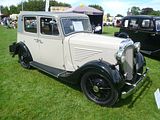
LANCIA
People tend to think that the entire Beta range was afflicted by the rust saga which effectively killed off the marque in the UK, but in fact, it was only really the early Berlina models that were affected. Of course, the rest of the range suffered from corrosion, but no more so than other cars of their era. What that means is that whilst there are very few Berlinas left on our roads, there are still rather more of the very stylish Coupe, HPE and Spider models. These are very desirable cars now, as they were when new, and none more so than an immaculate Coupe like this one.
At the time that this Flaminia Coupe was built, Lancia was still in the habit of going to more than one of the great Italian styling houses for designs, meaning that more than one different Coupe was offered in their range. This Touring designed car is the far more conventional (and elegant) of the versions offered.
This Delta Integrale arrived with the Pistonheads convoy at lunchtime.
LAND ROVER
Early Range Rover models have become quite collectible. The pre-production “Velar” cars are offered for between £60 – 80,000 when they come up for sale, which seems somewhat ambitious to me (but they do sell!). This one is not quite that old, but does show how the first cars, whilst considerable more luxurious and refined than a Land Rover, do appear rather basic compared to each successive evolution of the model.
LOTUS
These days you tend to see the Peter Stevens restyle of the Esprit far more often than the Giuigiaro original. It is the early cars that I prefer, visually, so it was nice to come across this Turbo model.
From the 1960s were an original Elan and the less commonly seen Europa
More recent Lotus models included an example of the front wheel drive Elan and an Elise
MARCOS
Compared to later evolutions of the basic shape that Marcos first showed in 1963, this 1970 3 litre GT looks somewhat simple, and unadorned, and there’s nothing wrong with that!
MASERATI
As well as the Ferraris, the same dealer had a duo of brand new Maserati on show: the new Ghibli was joined by the latest Quattroporte.
For some reason, this Merak had escaped my notice until I caught it departing the event late in the afternoon. These mid engined cars are still criminally undervalued for what they are, though with a does of Citroen complexity and Italian build, the phrase “caveat emptor” does apply more than usual!.
MAZDA
Among the many anniversaries of the year, 2014 marks 25 years since launch of the MX5 sports car, and 20 years since the founding of the Owners Club., and so there are extra special displays being mounted at a number of events during the year to celebrate. Following the very comprehensive display at Goodwood, it was good to see another sizeable assembly of cars here, with representatives from all three model generations present, and some limited edition cars including the 1991 model that was painted to match the Le Mans winning 787B, as well as a 20th anniversary car.
McLAUCHLIN
A new marque on me, I have to confess.
MERCEDES-BENZ
This an example of the first factory built Estate model that Mercedes made, the W123 which debuted in 1977. From tentative beginnings has come a major success as the Three Pointed Star diversified beyond regular saloon, coupe and convertible models. The W123 was almost hewn from granite, but many of these cars have moved on to a Second Life in Africa, so there are not that many left in the UK. This top of the range 280TE was in excellent condition.
Predecessor to the W123 were the W114/115 cars, and these came in a very stylish Coupe version as well as the saloon.
The long running R107 SL sports cars are deservedly popular, and although there are a lot of them around – thanks in no small part to the production life that ran from 1971 to 1989 – these cars are starting to go up in value, following on the heels of their predecessor, the W113 “Pagoda” which is now off limits for many buyers.
MG
Lots of example of what has to be one of Britain’s most popular classic cars., the MGB, in both open and GT guises, with a couple of the V8 cars among their number.
Although the B is the car that you see pretty much at any classic car event, the six cylinder model, the MGC, is starting to gain in popularity now, with prices rising as a consequence, and yes, there are plenty of survivors from the relatively short and low volume production run. Both Roadster and GT examples were displayed here.
The Midget is also a very popular classic, and there were plenty of these long running models (1961 – 1979) on show as well.
It was with the TC that sales of MG really took off, and more of these were made than any previous MG. Sales were particularly strong in the US, as returning GIs wanted a British sports car like the ones that they had seen and may be driven whilst over in Europe during and immediately after the war. The TC was followed by TD and TF models, and these were also present here.
Successor to the T Series car was the MGA, which was launched in 1955. There was one of these rather nice looking cars on show.
The Y Series was a sporting saloon sold in the late 1940s and early 1950s, precursor to the ZA Magnette, an example of which was also on display.
After the purists had calmed down about the idea of putting MG badges on family hatchbacks, cars like the MG Metro proved quite popular during the 1980s, though rust has claimed most of them. This was a nicely preserved late model.
A deserved prize winner was this absolutely stunning WA MG from the mid 1930s. The large MGs of the era are now getting all the plaudits they deserve, and rightly so too. Splendid!
MINI
No show of this scale would be complete without several examples of the Issigonis designed Mini, and sure enough, there were plenty of them here. Early cars are particularly popular at present, and they do present a charming simplicity.
This restored Van was particularly nice. Van models are far rarer than the saloons, as they tended to have a much harder life when new, and simply wore out.
Rarer still are the Pickups, and this one – beautifully restored – is believed to be the oldest surviving one of them all.
MITSUBISHI
The 3000GTO was launched in 1991 as a replacement for the Starion Turbo. This was the era when the Japanese crammed their high end Coupe models with as much technology as possible, not always with totally convincing results. Whilst this one was potent, and with four wheel drive and four wheel steering, as well as more acronyms to describe the electronic features than you could possibly remember, the end result was never that well regarded by the press. A certain section of the public, however, saw the appeal, and there has been a loyal following for the model ever since, with a lot of grey imports adding to the relatively small number of cars that were sold new here.
MORGAN
This was just the sort of day when a Morgan owner would have had a particularly enjoyable drive to and from the venue, able to enjoy that wind in the hair feeling, as they travelled on the country lanes around Sherborne, so no surprise that tehre were several of this oh-so-British classic here.
MORRIS
Needless to say, there were plenty of examples of the ever popular Minor, in Saloon, Traveller and Tourer guises.
Of course, the Minor name was not new when Issigonis’ 1948 masterpiece was unveiled, as Morris had first used it for their small car in the late 1920s that rivalled Herbert Austin’s big selling Seven. This is a nice example of the open tourer version from 1929.
Prior to the arrival of the Minor, Morris’ volume offering had been the Cowley, a model name used from the start of production in 1913, right up until 1959. This is a late 1920s model, with the flat radiator that came in after more than ten years of the rounded “bull nose” front ends.
Parked up next to the much derided Austin Ambassador was this Marina, and I was surprised not to hear the same scorn poured on it as to the larger Austin. This well preserved car sports the rare automatic gearbox.
NASH
One of the most impressive American cars on show was this, a 1950 Nash Airflyte Ambassador. This was clearly designed to reflect the Jet Age that the world was entering, with futuristic styling.
NISSAN/DATSUN
With model changes on a regular 4 yearly basis in the 1970s and 1980s, a vast number of different Datsun model types were sold, and whilst all bar the high end Laurel and Cedric/Gloria cars sold in large volume at the time, they all seem to have disappeared completely. Or so you might think until you come to an event like this, and lo, here was an immaculate 180B SSS Coupe dating from the late 1970s. Just when did you last see one of these?
You do see example of the Z car rather more frequently. Launched in 1969, this was the car that really stopped the British sports car industry in its tracks, or rather which should have set them on notice that you could build a car that was not only good to drive, but which was utterly reliable as well. Americans bought it in huge numbers, though Europeans were less convinced and so the car is not that common these days. This is a relatively early 240Z.
In complete contrast is the latest technology tour de force from Nissan, the blisteringly quick GT-R.
NOBLE
The striking M12 3GTO was parked up alongside the AC 378 and an Ultima. This design goes back a good few years now, but it remains a real crowd puller.
OLDSMOBILE
Hard to believe from the diminished sales figures which caused GM to kill the brand off, but for a number of years, the best selling model on the US market was the Oldsmobile Cutlass. The name first appeared in the 1960s and it was used for 35 years on a number of what its maker called mid-sized cars. When you look at this one, which dates from 1972, you many question how truly “mid-sized” it really was, but this is a relative not an absolute term!
PEUGEOT
Despite the use of the rather tappety ex Simca engines in all bar the top spec GTi models, the 309 was quite well thought of when new, but it has pretty much faded from view, with very survivors indeed, and most of them do seem unsurprisingly to be the GTi cars, so it was good come across the early GLD model in the car park.
Looking much more chic was this, a fabulous 304 Cabrio. Peugeot offered open topped versions of all their models in the 1960s and early 1970s, but they were expensive, so few were sold (and not all were even offered to UK buyers), so they are rare.
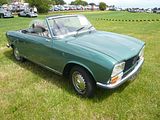
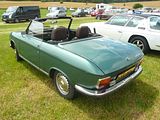
PONTIAC
When the first Firebird appeared, in 1967, it was closely related to the Chevrolet Camaro, and was a direct competitor to the by then well established Ford Mustang. It was a nicely compact car that looked good, and drove well (by the standards of the day). In subsequent generations, whilst the linkage to the Camaro remained very clear, the car grew and became less exciting to drive, with the nadir being reached at some point in the late 1970s and early 1980s. By the time GM tried to inject more excitement into the duo, the cars had become too large and flabby. and the market was not really interested in them, which was all rather sad for what had been a name to generate lots of excitement. No amount of sheet metal changes to improve the looks, or even the re-introduction of a proper convertible such as this one were going to get away from the fact that the car needed a complete rethink. That of course came, with the current Camaro, but that was all too late for the Firebird, as by that time Pontiac was dead, meaning that this is one of the last Firebirds made.
I recall seeing this giant Parisienne saloon at the Bristol Classic Cat Show a couple of months ago, so this was another chance to have a look at the vast leviathan of a saloon. Even by the standards of today’s ever larger models, it really is huge.
A slightly later Bonneville model, dating from 1967 was also on show, so in comparing the two, you could see a steady evolution of this full sized family sedan.
PORSCHE
The Porsche Owners Club had a vast display of cars, with just about every type of classic Porsche on show.
Dominant, of course were the 911 models, with everything from early 911 and 912 cars, through the G Series models, to the later 964. 993, 996 997 and current 991s all here.
The front engined cars were far from forgotten, though, with plenty of the 924 based range including 944 and 968 cars to look at.
This one is worth singling out, as it is believed unique in the UK. Before Porsche launched their own open topped version of the car, there were a number of kits offered to convert your 924 into a Cabrio, and this is one such, now beautifully restored.
There were also a number of 928s, including a nice late model S4
Although over 100,000 of the 914 cars were made, most went to America, so these are quite rare in the UK, so it was nice to see a well presented example here.
Spiritual successor to the car, I guess, is the Boxster, now coming up to its 20th birthday, and there were plenty of these and the closed roof Cayman cars as well.
Completing the display was a 356, the first production Porsche model.
RELIANT
Just one Reliant, an example of the Scimitar GTC
RILEY
There were also surprisingly few Rileys, with my camera finding just one example of each of an RM Series Saloon and a Convertible
ROLLS ROYCE
There were a number of very splendid 1930s Rolls Royce models parked up just behind the area where my car was located. but to my chagrin, I missed photographing some of them, as they departed relatively early during the afternoon. The ones I did capture included a Phantom III and a 1937 Sedanca de Ville
This Series 1 Silver Cloud was elsewhere in the show.
ROVER
The P4 had a long production life, running from 1948 until 1964, by which time it has been replaced by the far more modern P6. During this time, numerous changes were made, to the styling and the mechanicals, resulting in a sometimes bewildering array of different models, numbered 60, 75, 80. 90, 95, 100, 105 and 110. There were several different cars on show at this event.
Sole photographed example of the P6 model was this 2200SC car.
With even the very newest of the R8 Rovers about to celebrate its 20th birthday, I guess these cars are now “youngtimer” classics. Excellent cars when new, they were deservedly popular, though rust has claimed most of them now. The Cabrio model sold in small quantities, even though it was leagues better than the Escort and Astra models of the time against which it competed.
SAAB
The 96 V4 is one of those cars which you don’t see very often, and I’m never quite sure why. They had a certain following when new, were sold for a long time (over 15 years in the UK), and were certainly very tough, and yet on those rare occasions when you do see one, it tends to be just the one, not a whole array of them. This car dates from 1970 and had the Ford Taunus based V4 engine under its bonnet.
The 99 made its debut as a rather basic 2 door sedan in 1968 and it was gradually updated over the next 15 years, resulting in a bewildering array of different models. Solid but not that exciting, everything changed with the 1978 launch of the Turbo, with the result that all models in the range now generate some interest. This is a relatively late model GL.
STANDARD
This Standard Ensign was one of the cars offered for auction. I did not see the Auction House particulars, but can imagine that they used the time honoured phrase “barn find”, probably along with words like “project”. No doubt someone would buy what looked basically sound, but it will need a lot of work to bring it up to scratch, and that’s assuming the mechanicals are sound, which of course they may not be. The Ensign was the 4 cylinder low end relative of the Vanguard, and whilst fairly rare these days is hardly a high value collectible. Let’s hope someone throw away the economic business case and returns this car to its former glory!
SUBARU
The Subaru Owners Club had quite a sizeable display of cars, most of which were Impreza models. Indication of how Subaru lost their way (or changed their direction, if you are feeling charitable) comes from the fact that all the cars were from the first two generations of the model, with the later cars completely absent.
There was one Legacy among them.
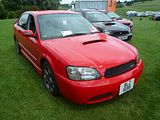
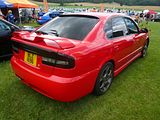
SUNBEAM
A splendid display of 1950s Sunbeams included a number of the 80 and 90 Sports Saloons as well as the open topped model, which was christened Alpine in recognition of the car’s success in rallying.
An earlier car was included in the display.
SUZUKI
The miniscule Cappuccino sports car is starting to pop up at classic car events all over the place. And why not? It has all the ingredients needed to qualify as a classic, with cheeky looks, a car that is fun to drive, and thanks to a short production life, relative rarity.
TORNADO
Definitely one of the lesser known marques of the event, I only knew what this was as I have seen the car before. This is a Tornado Talisman, a kit car made in the early 1960s.
TOYOTA
Gradually, older Japanese cars are making tentative appearances at classic car events. In Toyota’s case, it tends to be the MR2 model that dominates, and there were a few of these mid engined sports cars present.
There are other models from the back catalogue with a following as well, such as this late 1980s Supra and any number of the different generations of Celica that were made from 1971 until 2005. Some of these were offered in convertible guise, such as the one shown here.
TRIUMPH
Although the Stag gained a sadly deserved reputation for unreliability in its early days, known solutions to all the problems have long been found, meaning that this very elegant grand tourer should not frighten people off in the way it used to. Whilst values are still surprisingly low, there are plenty of enthusiasts for the model, and accordingly, an event like this always tends to feature lots of examples of the model. This was no exception, and there were plenty of Stags parked up, in an array of the different colours which were offered during the car’s 7 year life. To my mind, many of the bright colours suit it well, with Mimosa (bright yellow) being a favourite, and one you often see. One you don’t come across very often, but which was represented here is Topaz, a deep orange and one which I really rather like.
There have never been the same concerns about Triumph sporting TR series of cars, which have had an enthusiastic following right from launch in 1952. Not surprisingly, there were plenty of examples of all the different models here, with a TR3b, several TR4, TR5 and TR6
Other Triumphs included a 2000 Mark 1 and a Herald 13/60 Convertible
TVR
You don’t see early TVRs very often, not least because not that many were made. The early Grantura shape lived on into the 1970s, by which time the car had become the Vixen, or in more potent form the Tuscan and Griffith. This is a Vixen.
During the 1970s, TVR offered the M Series cars. A neatly styled closed coupe, they were offered with a variety of engines from Ford and Triumph. Entry level car was this, a 1600M.
Gradual evolution saw a hatchback added with the Taimar, and then an open topped model called 3000S which arrived towards the end of the decade.
TVR went all modern for the 1980s with the wedge styled cars. Offered initially with Ford’s familiar 2.8 litre V6 unit, things got far more interesting when the 3.5 litre V8 Rover unit was squeezed under the bonnet. Various ever more potent models arrived over the next few years, this 400SE being one such example
All change again in the 1990s, when the golden era of TVR really got underway with cars like the Griffith.
A string of new models followed in quick succession, all of which are familiar to many people, and they included the Tuscan, the T350C and the Tamora, all of which were to be seen at this event.
ULTIMA
VAUXHALL
There were very few Vauxhalls of any description in the event. One that caught my eye, and my camera was this FB version of the VX4/90. This was a sporting (it’s a relative term!) version of Vauxhall’s mid-sized family car of the early 1960s, with the 90 supposedly denoting the top speed.
VENTURI
These French cars of the late 1980s and early 1990s, based on Renault mechanicals only sold in small quantities, and so are rare, with just a few models in the UK.
VOLKSWAGEN
There were a number of examples of the classic Beetle, still a popular “starter classic”, thanks to good parts availability, and overall mechanical simplicity.
Early Golfs have definitely entered “youngtimer” classic status and this event contained a Golf Cabrio and the very rare (especially in the UK) G60
You don’t see old Scirocco models that often, and when you do, it tends to the second generation model, so it was nice to come across this facelifted Mark 1 car.
VOLVO
Back in the mid 70s, Volvo 145s like this, even down to the bright orange paintwork, were quite a common sight on our roads, as families who wanted commodious and reliable transport started to “buy foreign”. I even heard my father – not renowned for his enthusiasm for things automotive, or “foreign” – express the view that he would quite like one!
By the time that 145 was on sale, Volvo was concentrating solely on its large saloon and estate car range, but for some years prior to that, there had been an image building Coupe in the range, as well. The P1800 was first shown in 1960, and for the first couple of years of production, the bodies were made by Jensen in Castle Bromwich, before Volvo took complete production back in house. Made famous thanks to a starring role in The Saint, the car stayed in production throughout the 1960s, gaining a more powerful engine and minor trim changes, before a 1971 change to a three door hatchback design to rival the Reliant Scimitar GTE. Accordingly, this is one of the last Coupe models made.
WOLSELEY
This was a nice example of the 1500 saloon. a medium sized car which although intended to replace the Morris Minor only ever came in Wolseley and Riley versions, and production of which ended before the Minor reached the end of the line.
This was a really excellent day out. Perhaps thanks to the lovely weather, the show ended up being far bigger than I imagined, and it was quite a challenge to get to see it all in the day, and with over 1000 vehicles on show, I am sure that some key cars did elude my camera. There’s always a lot going on in July, but unless this one clashes with the unmissable Silverstone Classic, then I will be giving it a very high priority for 2015. Special thanks to Paul Hanmore and the Italian Motor Club for the kind invitation. It was a pleasure and an honour to join your display.

